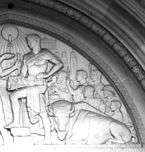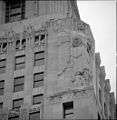Ulric Ellerhusen
Ulric Henry Ellerhusen (1879–1957) first name variously cited as Ulrich or Ulrik, surname sometimes cited as Ellerhousen) was a German-American sculptor and teacher best known for his architectural sculpture.
Ellerhusen was born on April 7, 1879 in Waren, Mecklenburg, Germany and came to the United States in 1894. He studied at the Art Institute of Chicago under Lorado Taft, and with Gutzon Borglum at the Art Students League of New York, and from 1906 through 1912 with Karl Bitter.[1] In 1915, Ellerhusen contributed unusual inward-looking figural sculpture for the colonnade of Bernard Maybeck's Palace of Fine Arts, working under Bitter, who was the director of sculpture for the San Francisco Panama-Pacific International Exposition (1915).[2]
In 1926 Ellerhusen worked with Lee Lawrie to produce about 70 integrated sculptural figures for the Rockefeller Chapel at the University of Chicago. Lawrie was responsible for the figures below the 30-foot level of the building, and Ellerhusen for the higher and less visible work. Ellerhusen's most notable contribution was the March of Religion, a series of fifteen monumental sized figures across the front gable. Unlike what is found in most churches, the people represented were not just drawn from the Judeo-Christian tradition but included Zoroaster and Plato as well as Abraham, Moses, the Prophets, Elijah and Isaiah and John the Baptist. Christ holds the center position. Next to him is Peter, then the Apostle Paul, Athanasius, Augustine, Francis of Assisi, Martin Luther and John Calvin make up the remaining figures in the gable. Elsewhere on the building Ellerhusen created figures of Amos, Hosea, John Huss, William Tyndale, St. Monica and St. Cecilia as well as the emblems for Matthew, Mark, Luke and John.[3]


Ellerhusen returned to the University of Chicago in 1931 to execute a panel for over the main entrance to the Oriental Institute's new building. This figures on this tympanum symbolize the passing of writing from the East to "vigorous and aggressive figure of the West.".[4] The East is represented by a lion in the foreground with Zoser, Hammurabi, Thutmose III, Ashurbanipal, Darius the Great and Chosroes farther back. The West has a bison as its totem while its great men are Herodotus, Alexander the Great, Julius Caesar, a crusader and two modern men, an excavator and an archeologist. Various examples of the great buildings form the background of both sections. The building picked to represent modern architecture is Goodhue's Nebraska State Capitol.
Although Ellerhusen and Lawrie worked together on several buildings it is only at Goodhue's Christ Church Cranbrook (1928) that it is difficult to determine who did what. It is likely that each did several of the figures independently, but their styles are so similar, and in this case the figures representing such atypically ecclesiastical people as Wilbur Wright, Louis Pasteur, Michael Faraday, Galileo Galilei, Johannes Gutenberg, Leonardo da Vinci, Abraham Lincoln and George Washington are closer to Ellerhusen's more relaxed and naturalistic style than Lawrie's.[5]
For the Louisiana State Capitol building Ellerhusen created "four colossal corner figures standing for 'four dominating spirits of a free and enlightened people,' " [6] Law, Science, Art and Philosophy. [7] He also produced a frieze Louisiana: History and Life that is divided into five parts and wraps around the building at the fifth floor level. In one section Ellerhusen used a son (Solis Seiferth, Jr.) and a daughter (Carol Dreyfous) of the building's architects as models for figures of children in his design.[8]
Ellerhusen, a longtime member of the National Sculpture Society, taught throughout much of his career, and spent the final years of his life in Towaco, New Jersey, where he had founded an art school and taught alongside his wife Florence Cooney Ellerhusen, a landscape painter.[9]
Gallery
 Christ Church, Cranbrook
Christ Church, Cranbrook


 Law
Law City Hall, Kansas City, Missouri
City Hall, Kansas City, Missouri City Hall, Kansas City, Missouri
City Hall, Kansas City, Missouri Figural sculpture representing 'Introspection' at the Palace of Fine Arts in San Francisco
Figural sculpture representing 'Introspection' at the Palace of Fine Arts in San Francisco The March of Religion on the Rockefeller Chapel, figure of Christ in the center
The March of Religion on the Rockefeller Chapel, figure of Christ in the center
Selected works
| Wikimedia Commons has media related to Ulric Ellerhusen. |
- Altar of Democracy (Peace Monument), East Orange, New Jersey, 1922
- Rockefeller Chapel at the University of Chicago, 1926
- Christ Church Cranbrook, Bloomfield Hills, Michigan, 1928
- Louisiana State Capitol, 1932
- Panels Atomic Energy and Stellar Energy on the facade of the Electrical Building at the Chicago Century of Progress Exposition, 1933
- First Permanent Settlement of the West (aka Pioneer Monument), Harrodsburg, Kentucky, 1934
- Kansas City City Hall, 1936, friezes on the east and west walls
- Gold Man (aka Oregon Pioneer) finial figure on the Oregon State Capitol, 1938
References
- ↑ Exhibition of American Sculpture Catalogue, 156th Street of Broadway New York, The National Sculpture Society 1923 p.55
- ↑ Neuhaus, Eugen, The Art of the Exposition, Paul Elder and Company, Publishers, San Francisco 1915
- ↑ Goodspeed, Edgar, J. The University of Chicago Chapel: A Guide, The University of Chicago Press, Chicago, Illinois, 1928
- ↑ The Oriental Institute of the University of Chicago In commemoration of the dedication of the Oriental Institute building, December fifth, 1931
- ↑ McMechan, Jervis Bell, Christ Church Cranbrook: 1928–1978, Christ Church Cranbrook, Bloomfield Hills, Michigan 1979
- ↑ Garvey, Timothy Joseph, Lee Lawrie Classicism and American Culture, 1919 - 1954, PhD. Thesis University of Minnesota 1980
- ↑ Agard, Walter Raymond, The New Architectural Sculpture, Oxford University Press, NY, NY 1935
- ↑ Kubly, Vincent, The Louisiana Capitol-Its Art and Architecture, Pelican Publishing Company, Gretna 1977
- ↑ Bzdak, Meredith Arms; and Petersen, Douglas. Public sculpture in New Jersey: monuments to collective identity, p. 1922, Rutgers University Press, 1999. ISBN 0-8135-2700-7. Accessed February 23, 2011.
- Kvaran and Lockley, Architectural Sculpture in America, unpublished manuscript
- Opitz, Glenn B, Editor, Mantle Fielding’s Dictionary of American Painters, Sculptors & Engravers, Apollo Book, Poughkeepsie NY, 1986